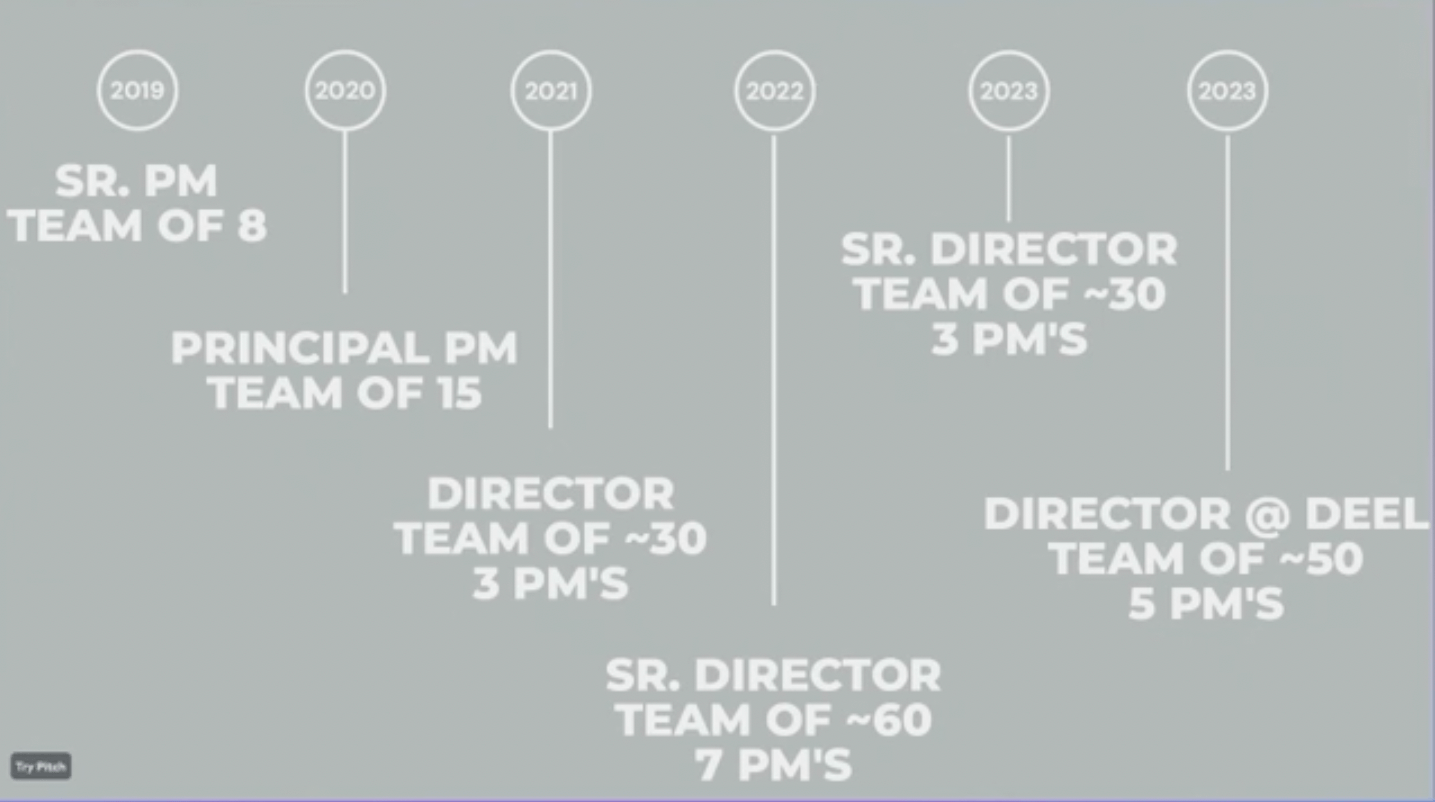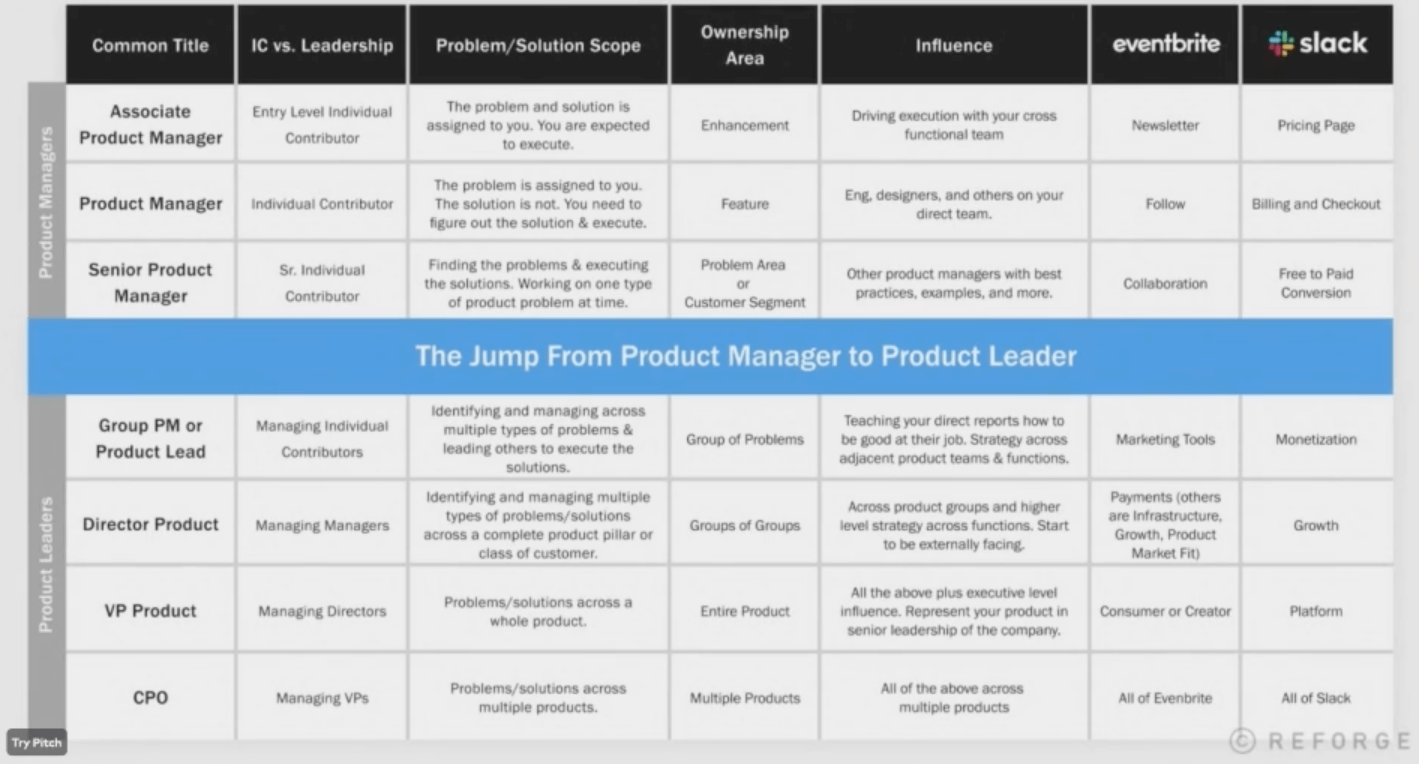Markiyan Matsekh, Director of Product at Deel, gave this presentation at the Product-Led Summit Berlin in 2023.
Today, I’m going to talk about promotions. I was lucky to get promoted three times in three years, which doesn't happen often. But career progressions can be very random. This is what happened right after I got promoted to senior director at my previous company:

I got demoted, my team was reduced, and my direct reports were reduced. Then I moved to another company where the team was a little bigger. I want to emphasize the luck element in all this, but I think there are a number of elements in my story that you can use to help with your own career.
PM titles differ between companies. For example, a group PM at Google is the equivalent of a director at Amazon. But through the core principles that I'm going to talk about, you’ll discover that there are several stages of PM career progression.
- How career growth happens
- The expectations of a principal PM
- Progressing from a principal to a director
- Behind the scenes of a promotion
- Transitioning from director to VP
- The luck factor
How career growth happens
My journey started one month after I joined my previous company, Vimeo. My manager approached me with an unusual question. He asked me if I’d like to lead one more team of the same size.
My reaction to this was, “Of course, yes. But hold on, what does this mean for my existing team? How am I going to manage two teams? Is someone else taking my team?”
It raised a lot of questions because I was expected to lead two teams of six or seven engineers.
In the end, I accepted his proposal. It would’ve been silly not to try and do it. But this situation is very demonstrative of how career growth happens.
So, let me break it down for you.
First of all, you do your job very well. It's the foundation for any sort of career growth. Then, your manager needs to notice it.
After that, it might take a long time, but some new opportunity comes up. For example, someone leaves the company or the business decides to launch a new product. Because your management has noticed that you’ve been doing a good job, they decide to assign this new opportunity to you.
After that, you need to live up to the challenge. And once you do, that's when you get promoted.
In the one month that I was at Vimeo, I was able to establish a fairly good connection with my management. I built rapport with my team, built the roadmap, shipped a couple of things, and just showed some basic competency.
This was good enough because my manager approached me when another PM from my team had left.
My manager was faced with a choice. Did they want to spend another three to six months hiring someone? Did they want to do it themselves? Or did they want to give this job to someone on the team?
I fit the job for a number of reasons. Outside of doing a fairly okay job, the team spoke the same language as I did, which was Ukrainian.
I was trusted with more ownership and more responsibility, and apparently, it worked because, at the end of the year, I got promoted. It took me about nine months after that conversation and about one year after I joined Vimeo to get promoted.
The expectations of a principal PM
So, why was I promoted?
There were a couple of things that were expected of me that I did.
As a principal PM, you're expected to:
- Solve problems with more ambiguity
- Have more accountability for business impact
- Influence other product managers
- And lead two products in parallel
I want to talk a bit more about the two products in parallel because I have mixed feelings about it.
As you grow as a PM, you can make decisions faster, you're more efficient, and you’re more productive. That means that you can produce more user stories, more roadmaps, and more items faster for a larger team.
At the same time, it's critical for your future career growth because as you progress toward a leadership role, you’ll manage multiple products unrelated to one another, and you’ll have to be able to manage multiple priorities, threads, and customer requests. So, it's very important to start developing the mindset by developing multiple products.
On the other hand, the trade-off with this is that you have to make shortcuts, and you sometimes have to make quick decisions that you wish you had more time to gather data for. You end up making shortcuts, which isn’t great, but most people I've talked to have a similar practice, so it's something you can expect.
Once you get an opportunity to lead more than one product, it's a good career signal. I recommend you take it and learn it on the fly, but it's going to be stressful.
This is a PM competency matrix. It’s a good overview of what a career ladder is and what our expectations are from different seniority levels.

Your company should have one. If it doesn't, it's very valid to ask your management to build one. It's an extremely helpful tool for career growth and helps you see the different expectations from different levels.
Progressing from a principal to a director
The hardest thing for a PM career progression is to go from an individual contributor to a product leader or people manager.
Now, we’ll look at the path from a principal to a director. The reason it's so hard is because you have to juggle a couple of very different priorities.



 Follow us on LinkedIn
Follow us on LinkedIn



